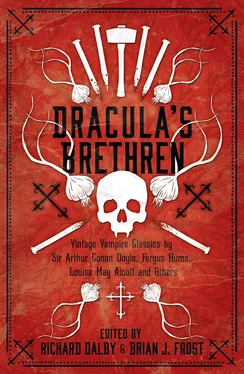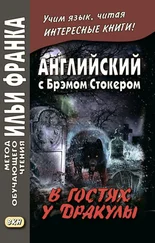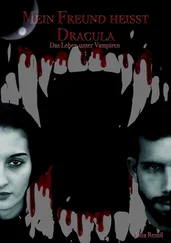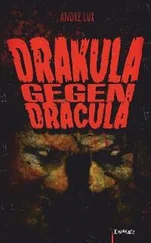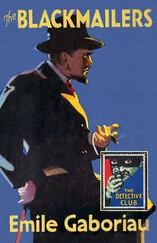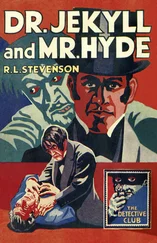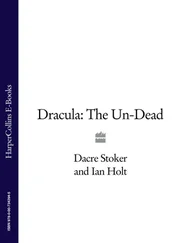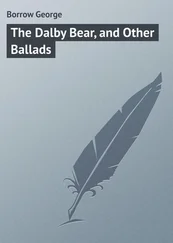Some of the best stories from the Edwardian era feature vampires in unusual guises. In Morley Roberts’ ‘The Blood Fetish’ (1909), for example, a severed hand lives on as an independent entity by absorbing the blood of both animal and human victims. In another morbid tale, Horacio Quiroga’s ‘The Feather Pillow’ (1907), a young woman has all the blood gradually sucked out of her by a monstrous insect secreted inside the pillow on her bed; and in F. H. Power’s ‘The Electric Vampire’ (1910) a mad scientist creates a giant, electrically-charged insect which feeds on blood. Even more bizarre is Louise J. Strong’s ‘An Unscientific Story’ (1903), in which a professor who has succeeded in breeding the ‘life-germ’ in his laboratory soon realises the folly of his experiments when his creation grows at a fantastic rate and within a short time forms itself into a humanoid creature which exhibits a craving for blood.
The first anthology to gather together a sizeable number of stories from this golden age of vampire fiction was Richard Dalby’s Dracula’s Brood (1987), which contained twenty-three rare stories written by friends and contemporaries of Bram Stoker. Then, after years of searching through dusty old books and defunct magazines, Richard and fellow vampire enthusiast Robert Eighteen-Bisang compiled an even rarer collection of stories for their 2011 anthology Vintage Vampire Stories . Now, after more diligent searching, Richard and I have put together this stunning new collection of stories, nearly all of which have been unavailable for many years, and include several forgotten gems whose resurrection from an undeserved obscurity should finally bring them the recognition they deserve.
BRIAN J. FROST
THE BRIDE OF THE ISLES
A Tale Founded on the Popular Legend of the Vampire
Anonymous
When this story, which is based on James Robinson Planché’s play The Vampire; or, The Bride of the Isles , received its first publication in 1820, the publisher, J. Charles of Dublin, took the liberty of falsely attributing it to Lord Byron, and the real author is unknown. Nevertheless, it is an excellent example of the bluebook or ‘Shilling Shocker,’ which were the terms usually used to describe short Gothic tales published in booklet form during the early 19th century. Retailing between sixpence and a shilling, they were about four by seven inches in size, and their closely printed pages were stitched into a cover made of flimsy blue paper. These luridly illustrated publications were especially popular with members of the lower classes, many of whom craved the thrill of reading stories revolving around shocking, mysterious and horrid incidents, but couldn’t afford to buy expensive Gothic novels, which were often published in three volumes. A copy of the rare 1820 first edition, complete with its coloured frontispiece, fetched £2000 at auction three years ago.

‘THOUGH the cheek be pale, and glared the eye, such is the wondrous art the hapless victim blind adores, and drops into their grasp like birds when gazed on by a basilisk.’
THERE IS A popular superstition still extant in the southern isles of Scotland, but not with the force as it was a century since, that the souls of persons, whose actions in the mortal state were so wickedly atrocious as to deny all possibility of happiness in that of the next; were doomed to everlasting perdition, but had the power given them by infernal spirits to be for a while the scourge of the living.
This was done by allowing the wicked spirit to enter the body of another person at the moment their own soul had winged its flight from earth; the corpse was thus reanimated – the same look, the same voice, the same expression of countenance, with physical powers to eat and drink, and partake of human enjoyments, but with the most wicked propensities, and in this state they were called vampires. This second existence as it may not improperly be termed, is held on a tenure of the most horrid and diabolical nature. Every All-Hallow E’en , he must wed a lovely virgin, and slay her, which done, he is to catch her warm blood and drink it, and from this draught he is renovated for another year, and free to take another shape, and pursue his Satanic course; but if he failed in procuring a wife at the appointed time, or had not opportunity to make the sacrifice before the moon set, the vampire was no more – he did not turn into a skeleton, but literally vanished into air and nothingness.
One of these demoniac sprites, Oscar Montcalm, of infamous notoriety in the Scotch annals of crime and murder (who was decapitated by the hands of the common executioner), was a most successful vampire, and many were the poor unfortunate maidens who had been sacrificed to support his supernatural career, roving from place to place, and every year changing his shape as opportunity presented itself, but always chosing to enter the corpse of some man of rank and power, as by that means his voracious appetite for luxury was gratified.
Oscar Montcalm had seen, and distantly adored in his mortal state, the superior beauty of the Lady Margaret, daughter of the Baron of the Isles, the good Lord Ronald; but, such was his situation, he had not dared to address her; however, he did not forget her in his vampire state, but marked her out for one of his victims, in revenge for the scorn with which he had been treated by her father.
Lady Margaret, though lovely and well proportioned, entered her twentieth year unmarried, nor had she ever been addressed by a suitor whom she could regard with the least partiality, and with much anxiety she sought to know whether she should ever enter into wedlock, and what sort of person her future lord would be. With credulity pardonable to the times in which she lived, and the narrow education then given to females, even of rank, she consulted Sage, Seer and Witch, as to this important event; but it is not to be wondered at that she met with many contradictions, everyone telling a different tale. At length urged on by the irresistible desire to pry into futurity, she repaired with her two maidens, Effie and Constance, to the Cave of Fingal, where, cutting off a lock of her hair, and joining it to a ring from her finger, she cast it into the well, according to the directions she had received from Merna, the Hag of the mountains, who had instructed the fair one as to this expedition.
No sooner was the ring flung into the well than a dreadful storm arose; the torches, which the attendant maidens had borne, were extinguished, and the immense cave was in utter darkness: loud and dreadful was the thunder, accompanied by a horrid confusion of sounds, which beggars description.
Margaret and her companions sunk on their knees; but they were too stupefied with horror to pray, or to endeavour to retrace their way out of this den of horrors. Of a sudden, the cave was brilliantly illuminated, but with no visible means of light, for there were neither torch, lamp, or candle. Solemn music was heard, slow and awfully grand, and in a few minutes two figures appeared, one heavy, morose in countenance, and clad in dark robes, who announced herself as Una, the spirit of the storm, and touching a sable curtain, discovered to the view of Margaret the figure of a noble young warrior, Ruthven, Earl of Marsden, who had accompanied her father to the wars. Again the storm resounded, the curtain closed, and the cave resumed its darkness; but this was only transient – the brilliant light returned – Una was gone, and the light figure, dressed in transparent robes, sprinkled over with spangles remained. With her wand she pulled aside the curtain, and a young man of interesting appearance was visible, but his person was a stranger to the fair one. Ariel, the spirit of the Air, then waved her hand to the entrance of the cave, as a signal for them to depart, and bowing low, they withdrew, amid strains of heart-thrilling harmony, rejoiced to find themselves once more in an open space, and they happily returned in safety to the baron’s castle. The Lady Margaret was well pleased with what she had seen, as promising her two husbands, though she was somewhat puzzled by calling to mind a couplet that Ariel had repeated three or four times, while the curtain remained undrawn.
Читать дальше
